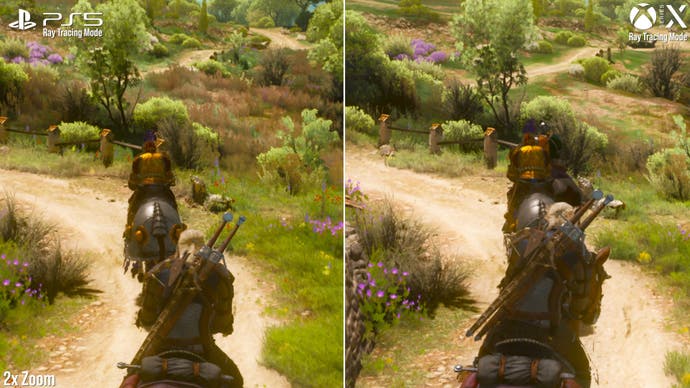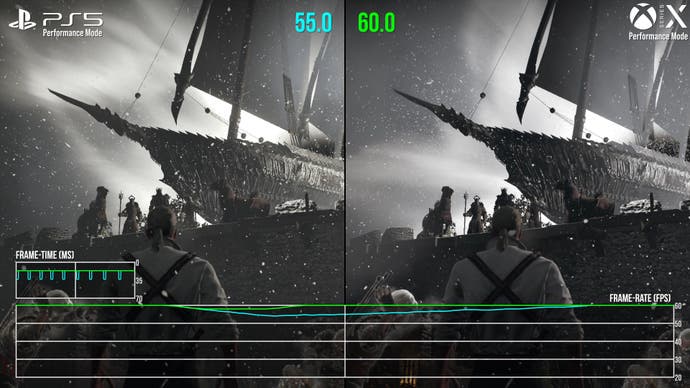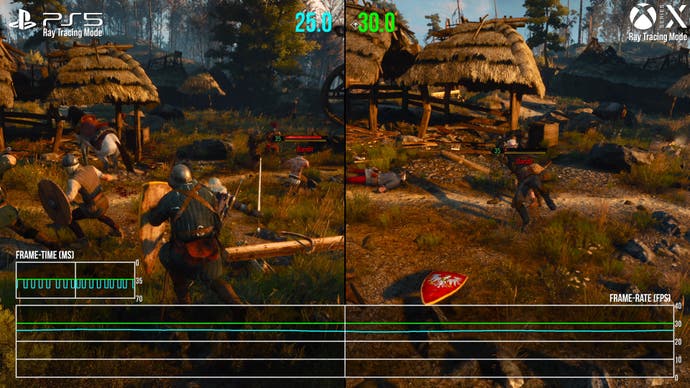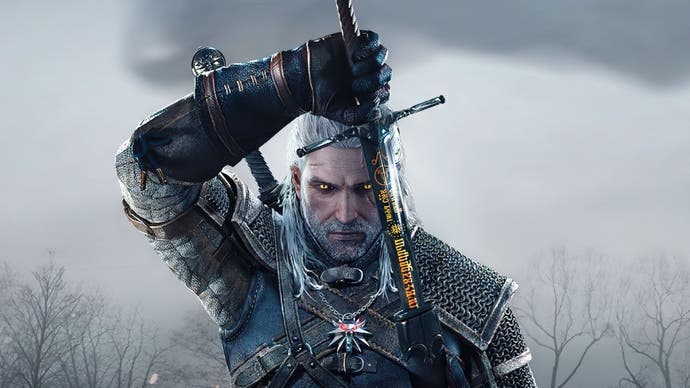The Witcher 3 next-gen: ray tracing and performance modes tested on PS5 and Xbox Series X
The RT effect is beautiful - but performance is the best way to play.
Seven years since its first release, the new The Witcher 3 Complete Edition aims to enhance an already iconic game with a huge suite of extras. On PS5, Xbox Series X, S and PC, it's a free update listed as patch 4.0. Visuals are enhanced, quality of life improvements are added, plus we get extras to tie into the Netflix TV show. This much we already knew from our preview after a visit to CD Projekt RED's offices - but now it's time to put the console code to test across all of our established test areas. We'll be kicking off with Series X and PS5 analysis, covering off performance and RT modes, with the non-RT Series S version to follow. First impressions? Neither mode on either console is the finished article, but right now, we'd recommend the performance mode on both flagship consoles.
The original release looked good, but the next-gen patch - the Complete Edition - does indeed benefit from enormous improvements. A bulk of the textures and models are reworked, with CDPR contracting PC modder Halk Hogan - who produced the HD Reworked Project mod - to incorporate new, updated assets into the official release. Foliage is improved too, filling out the landscape with more plant life. There are smaller touches as well, like brand-new skyboxes, weather states and lens effects, adding variety as Geralt travels the world.
Performance and RT modes on both Series X and PlayStation 5 have an established visual set-up in terms of the core artwork and engine 'settings', the differences coming down to native resolutions and the optional inclusion of ray tracing features. Pitting PS5 against Series X in their RT modes first, each targets a native 1440p, reconstructed to 4K using FSR 2.1, with dynamic resolution scaling taking the pixel count down to 1080p at its lowest. A bulk of pixel counts do hit that top 1440p number, however. Meanwhile, performance mode is bumped to a higher target on each, aiming for a native 4K - with 1080p remaining as the lower bounds. The net result is that both PS5 and Series X do on average look sharper in the performance modes compared to running on the RT mode.
There are key visual differences between PS5 and Series X. Firstly, it's clear Series X often runs at a higher pixel count on average than PS5, within theiir dynamic range. In particular on performance mode, a Novigrad run in puts us at 1440p on PS5, and closer to 1800p on Series X for a spell. Secondly, there are very visible differences in foliage and shadow draw distance. Curiously, PlayStation 5 level of detail is ramped up in a way that Xbox Series X is not - and it's certainly noticeable in head-to-head comparisons in terms of the density of grass to the far distance - and also the shadow map cascade.
The star of the show is the ray tracing mode. PS5 and Series X's ray tracing mode lowers resolution and adjusts target frame-rate to 30fps - and similar to the effect on PC, the transformation is remarkable. Ray-traced ambient occlusion and RTXGI global illumination replace the more approximate cubemap-based lighting, radically transforming the fidelity of the scene. Light bounces more realistically, darkened areas lack the blue-ish glow of the original lighting and the net result is often extraordinary. In retaining AO and GI features, CD Projekt RED has brought the best of the PC's upgrades to console users.
Of course, not every effect makes it to the PS5 and Series X. The RT shadows of the PC version are not present (and as is, they are bugged, per Alex's tech review), while PC's RT reflections are replaced with a screen-space alternative, only present in the 30fps RT mode. This SSR solution is significantly improved over what came before: it's higher resolution and now applies to more materials in the game, including armour and bodies of water. Previously The Witcher 3 used simpler cube-mapping to create a base reflection for puddles, but now we get a much-improved effect. It's not ray tracing, then - sadly - but the SSR upgrade is huge compared to the performance mode, which still uses the older technique.

The Complete Edition delivers on the visual front and the trades between RT and performance modes are fair. However, in terms of actual performance, both modes have issues and I'd say that the ray tracing mode simply doesn't run well enough to make it worth considering. On balance, I'd recommend the performance mode for both Series X and PS5 users. Up front I will say that most areas are a locked 60fps; it's really excellent. The White Orchard and even Crookback Bog run surprisingly well at 60fps on both PS5 and Series X - barring the odd one-frame hitch, or auto-saving stutter. However there are stress points, and some - like Novigrad City - are integral to your enjoyment of the game. For Novigrad, PS5 is consistently ahead of Series X around the Hierarch square - with a gap of 6-7fps in PS5's favour at times.
It's not clear why there's bigger drops on Series X here. However, PS5 can have its own performance deficits up against the Microsoft console elsewhere - battling the bandits just before the Blood and Wine expansion kicks off, PS5 wavers below the frame-rate target while Series X clears it at a perfect 60fps lock. Performance advantages for Series X do need to be taken in context, however, as draw distances are pared back noticeably - a difference that CDPR must surely address at some point. Regardless, the game plays best in performance mode and both consoles have the VRR support to make the small drops you do see an irrelevance if you have the appropriate HDMI 2.1 display.
The 30fps ray tracing mode is problematic, however. Adding new features to PS5 and Series X like RTAO and RTXGI makes this far more taxing on both machines. And to be blunt, in my experience playing PS5 to start, this mode's just not a 30fps lock. Even basic horseback routes, battles, and cutscenes slip into the high 20s and a sustained 25fps at points. It especially sticks out switching from the mostly smooth performance mode at 60fps, and even the old PS4 Pro version runs more smoothly at its own 30fps target. The brutal reality is, for all the benefits RT mode brings, it feels unpleasant to actually play this way. Novigrad is especially rough on PS5 in this case, and any panning motion - especially without motion blur enabled - makes for tough viewing.




Series X fares much better in overall frame-rate at 30fps. In fact, a bulk of play locks to the target with no problems at all on. Series X in RT mode runs better than PS5 for almost every case. The one area Series X does buckle is in Novigrad, dropping to as low as 23fps - a seriously choppy area - and where PS5 has equally poor performance. The likeliest culprit based on PC testing is a CPU side bottleneck on both sides, though Series X is again typically a frame or two to the better here, reflecting its higher clocks. Put simply though, the RT mode struggles to run well in the big city for both PS5 or Series X. Outside the city though? Series X has a much more level 30fps.
Even so, there are further issues. Similar to what we saw with Cyberpunk 2077's RT mode when its next-gen patch emerged, input lag is an issue - it feels noticeably worse to play. Taking a 120fps camera and measuring from a nudge of the right analogue stick, it takes the performance mode 92ms to respond with the first frame of camera movement, while the RT mode clocks in at 157ms. These figures includes our display lag of 22ms - meaning this is a 70ms response for performance mode, and 135ms in the RT offering. Either way, the bottom line is that RT mode adds an extra 65ms of latency compared to the performance mode, whoch is keenly felt and impacts enjoyment of the game.
The verdict on which version is best is hardly clear cut then. You get better foliage and shadow draw on PS5, but worse performance in its RT mode - and to be clear, neither console in RT mode feels great owing to the higher input latency. Certainly the 60fps performance mode improves the stuttering frame-rates and higher latency. In my case I actually ended up using the performance mode exclusively, just because it lessens those distractions - but it's a shame to lose the ray-tracing features. There's no perfect solution right now.
I've experienced stability issues during play too, with crashes to the front-end on both PlayStation 5 and Series X consoles. Even loading a save game has caused lock-ups on PS5, forcing me to just close the app and restart it. Addressing issues like this must surely be on CDPR's radar for the next patch - and I'm hoping it lands sooner rather than later. Again it's a sign this update just needed more time in the oven.
Finally, loading times are dramatically improved from the last-gen versions. This is a huge positive to end on. For example, loading a save to Velen village takes PS4 Pro 1 minute 35 seconds, but If we switch to the new generation machines, this wait is reduced to just over 13 seconds on PS5, and 16 seconds on Series X. The Witcher 3's faster loading times ranks as a huge step forward for the game's playability, regardless of which you choose.
Overall, The Witcher 3 Complete Edition is an ambitious next-gen release and it's fantastic that CD Projekt RED is giving away the update for free when it does so much more than many paid-for remastered. Equally though, being free doesn't spare it from criticism. The main issues with it for now relate to stability - the crashes on PS5 and Series X - and also performance struggling to hit a locked 30fps in the RT mode, notably on PS5. Features-wise, it's also odd that Series X isn't as dense in detail as PS5, which should be a huge advantage over the last-gen release.
More positively, the loading time boosts are fantastic, as are the ray tracing extras, the updated foliage, shadows, models and textures. However, the basics of hitting a consistent, smooth frame-rate are a must, especially after playing PS4 Pro or Xbox One X versions - which ran fine on these newer machines. Otherwise, it's hard to imagine much more being added to The Witcher 3 via a free update. After all it's a seven year old game, using the same engine as before; it's just these last lingering few issues introduced by the patch definitely need fixing.



